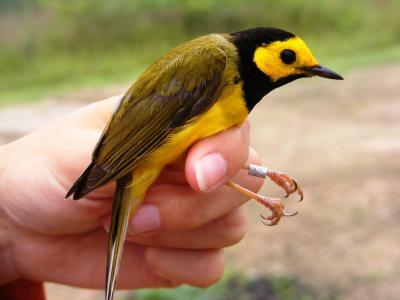IRVINE, Penn., August 21, 2013 – Efforts to conserve declining populations of forest-interior birds have largely focused on preserving the mature forests where birds breed, but a U.S. Forest Service study suggests that in the weeks leading up to migration, younger forest habitat may be just as important.
In an article published recently in the American Ornithologist Union's publication "The Auk," research wildlife biologist Scott Stoleson of the U.S.
Forest Service's Northern Research Station suggests that forest regrowth in clearcuts may be vital to birds as they prepare for fall migration. The article, "Condition Varies with Habitat Choice in Postbreeding Forest Birds," is available at: http://www.nrs.fs.fed.us/pubs/43984
The study suggests that declines in forest-interior species may be due in part to the increasing maturity and homogenization of forests. Openings created by timber harvesting may increase habitat for some forest interior birds, according to Stoleson. "Humans have really changed the nature of mature forests in the Northeast," Stoleson said. "Natural processes that once created open spaces even within mature forests, such as fire, are largely controlled, diminishing the availability of quality habitat."
On four sites on the Allegheny National Forest and private timber inholdings in northeastern Pennsylvania, Stoleson set out to learn where the birds spend time after breeding season and what kind of condition are they in leading up to migration. "After the breeding season, birds sing less, stop defending territory, and generally wander. Tracking them is challenging at this point in their life cycle," Stoleson said. Between 2005 and 2008, he used constant-effort mist netting to capture songbirds, band them, determine whether they were breeding or postbreeders, and assess their overall condition, including whether they were building fat deposits and the extent of parasites the birds carried.
In 217 days of netting birds over the course of the 4-year study, Stoleson netted and banded a total of 3,845 individuals. Of these, 2,021 individuals representing 46 species were in the postbreeding stage, based on physiological criteria. Of these, 33 percent were mature-forest specialists, 22 percent were forest-edge species, and the remaining 45 percent were early-successional specialists. All 46 species were captured in cuts, but only 29 species were captured within forest.
Stoleson's research concluded birds' use of young forest in the postbreeding season is correlated with better physiological condition for some forest birds, which suggests that the maintenance of such early-successional habitats in mature forest may benefit these species. Study results did not find a correlation between habitat and the presence of fat or parasites.
"Forest Service science contributes directly to healthy, sustainable forests that are more productive and, ultimately, produce cleaner air and water. Birds can help. Research has demonstrated that are our forest birds, through seed distribution and insect control, play a vital forest stewardship role," said Michael T. Rains, Director of the Northern Research Station and Forest Products Laboratory.

Forest Service research wildlife biologist Scott Stoleson banded and checked the overall condition of 3,845 birds in a 4-year study and found that the use of young forest correlated with better physiological condition for some forest birds, such as the hooded warbler pictured.
(Photo Credit: Scott Stoleson, U.S. Forest Service)